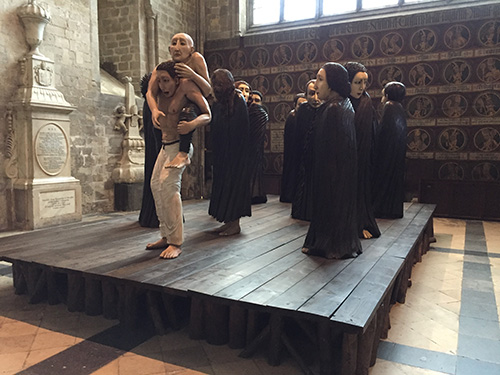Writing for Fun

November 2016
Shadows of the Wanderer - Jeanette Rothwell
Peter and I were on our way to Hayling Island for a short break and on the way there we took a diversion to visit Chichester for lunch. As soon as we arrived, the Cathedral loomed large and inviting and we decided to sample the home-cooked delights of the Cathedral Cafe. We then started to take a tour of the Cathedral itself. Half way round, a volunteer guide urged us to visit the exhibition in the North Transept which would be quite dramatic.
As soon as we entered the area of the exhibition we were struck by the spookiness of the atmosphere. Some weird music was being quietly played in the background and it was decidedly cold in there even though it was a sunny Autumnal day outside.
As we entered, I took this photo of the exhibition by sculpture artist Ana Maria Pacheco and then read the details in the leaflet:
‘Ana Maria Pacheco’s work has been noted as occupying an area between theatre and art – and this striking exhibition is no exception. Here, in the Cathedral’s North Transept, we offer a thought-provoking set of sculptures depicting a scene that resonates with some of our most pressing contemporary issues.
‘Shadows of the Wanderer’ presents a complex scene of twelve figures, each of them larger than a human and carved out of a single lime tree. Ten of the figures stand in the shadows around a young man who is carrying an older man on his back. These two central figures have been symbolically carved out of the same piece of wood and draw from Virgil’s Aeneid. In Virgil’s ancient poem, dating from 29BC, a young man, Aeneas, carries his lame father on his back and flees from the burning ruins of Troy. Pacheco’s contemporary – and challenging – depiction of this scene resonates powerfully with current debates about exile, migration, and the displacement of people who are trying to escape persecution in our own day. Consequently this exhibition is supported by Amnesty International; Kate Allen, Director of Amnesty International UK, explains: ‘We are delighted to be supporting this timely and poignant installation at Chichester Cathedral – how we choose to respond to refugees is one of the most important questions on our national and international agenda.’
Each of the figures in this installation has their own story to be interpreted – the older man reaches out to the audience and looks forward, perhaps hoping for a new transformation. By contrast, the younger man concentrates on the heavy load he bears and the arduous ground before him. The towering figures in the shadows around the wanderer are clad in dark robes, their differing postures and expressions suggesting a range of profound emotional reactions; one might be showing anguish, but another, denial. With eyes made from onyx, they invite our gaze and our reflections; what does it feel like, for example, when the way home is not the way back?”
The lighting in the area was very cleverly spotlighted on the figures angled to catch their expressions. We slowly walked around the raised decking on which the figures stood and as we reached the end of the exhibition and made our way to the exit, a tall figure entirely clothed in black loomed up before us. The weird music and cold atmosphere had got to us and we both almost jumped out of our skins when this happened.
When we looked up at the dark figure we realised it was a church dignitary dressed in the usual cassock and he then beamed at us, hoped we had enjoyed the exhibition and wished us a safe onward journey.
When we got outside the Cathedral, we both agreed that the whole experience had been extremely spooky.
